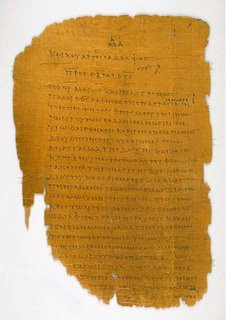FACING THE TRUTH
 If we want to come to satisfying conclusions on the hazy issues within Christianity, such as homosexuality, eternity, sin, etc, the general consensuses is that we must enter into the world of Greek and Hebrew semiotics, i.e. a study into contextual definitions of Greek and Hebrew words and characters. I agree that this is an important task in getting deep with biblical analysis.
If we want to come to satisfying conclusions on the hazy issues within Christianity, such as homosexuality, eternity, sin, etc, the general consensuses is that we must enter into the world of Greek and Hebrew semiotics, i.e. a study into contextual definitions of Greek and Hebrew words and characters. I agree that this is an important task in getting deep with biblical analysis.However there is vital a step before this which I believe is often ignored. When this step is neglected people often draw faulty conclusions. This step is so often neglected because it questions the very thing many Christians believe is an absolute. That is, testing the reliability of the actual verse or scripture being studied.
If we are to attempt to find the essence of Christianity, we must not only acknowledge but study the circumstances that the cannon which we call the New Testament reached us. We must understand the reasons why various ancient writings were included and excluded in the cannon. We must also be real in studying how reliable and unaltered the cannon books really are.
“Some would point to the discovery, throughout the course of the twentieth century, of ancient manuscripts of the New Testament, hundreds of years older than the manuscripts available to early Bible translators, such as those responsible for the King James Bible. Among other things, these early manuscripts are significant for showing that the books of the New Testament were not copied with the assiduous care you might think or hope for. In fact earliest copyists appear to have been untrained and relatively unsuited to the tasks; they made lots of mistakes, and those mistakes were themselves copied by subsequent copyists (who had only the mistake ridden copies to reproduce…” (B.D. Ehrman, Lost Christianities 2003, Oxford University Press. New York)
Before the gospels, of which there are far more of than the four included in the New Testament cannon, were put down on paper, the stories of Jesus spread via the rich oral traditions of the time. Oral traditions are not known for semiotic accuracy but rather to share the point of a message.
The generally agreed upon dates that the gospels were written are:
Mark: c. 68–73
Matthew: c. 70–100 as the majority view; the minority of conservative scholars argue for a pre-70 date, particularly those that do not accept Mark as the first gospel written.
Luke: c. 80–100, with most arguing for somewhere around 85
John: c. 90–110. The majority view is that it was written in stages, so there was no one date of composition.
“The dominant view today is that Mark is the first Gospel, with Matthew and Luke borrowing passages both from that Gospel and from at least one other common source, lost to history, termed by scholars 'Q' (from German: Quelle, meaning "source"). This view is known as the "Two-Source Hypothesis". The rediscovery of the Gospel of Thomas, a sayings gospel remarkably similar to the form that Q was thought to take, and containing many of the sayings shared only between Matthew and Luke, but in a more raw form, has given a large degree of credence to the hypothesis. Others note that since the Gospel of Thomas is thought to be a later document than the synoptics, Thomas copied from them.”
(http://en.wikipedia.org/wiki/Gospel)
Also, there are some examples of specific texts within the New Testament that scholars believe had been tampered with or added to during copying and translating.
The unreliable and ambiguous history of the New Testament can cause problems when one studies the root Greek meanings of specific English words and draws definite conclusions on morality and boarders within Christianity. I am not saying that understanding the Greek, Hebrew and Aramaic and contextual meanings isn’t an important thing, quite the opposite. Everything to do with the history of the text must be taken into account, including reliability.
I do think that this adds to the argument that no one can ever claim an exclusive knowledge and an authoritative claim to biblical ‘truth’.
Have you read Marcus J Borg, "Reading The Bible Again for the First Time"?
From the cover: "Marcus Borg reveals how it is possible to reconcile the Bible with both a scientific and critical way of thinking and our deepest spiritual needs, leading to a contemporary yet grounded experience of the sacred texts."
I got it from the library today; will let you know what I make of it.
Posted by Anonymous |
7/02/2006 10:57:00 pm
Anonymous |
7/02/2006 10:57:00 pm